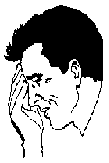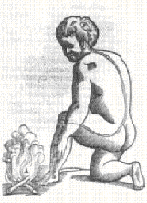 Pain
and Why It Hurts Pain
and Why It Hurts  |
 Pain
and Why It Hurts Pain
and Why It Hurts  |
 You may
not like it, but we need pain. Pain acts as a warning system that protects
you. Pain says, "Warning, Warning....stop what you doing and do something
else". For example, if you have your hand on a hot stove, pain tells you
to stop touching the stove and remove your hand. In this way, pain
protects your body from injury (or further injury if you have already hurt
yourself). Pain also helps healing...because an injury hurts, you rest. You may
not like it, but we need pain. Pain acts as a warning system that protects
you. Pain says, "Warning, Warning....stop what you doing and do something
else". For example, if you have your hand on a hot stove, pain tells you
to stop touching the stove and remove your hand. In this way, pain
protects your body from injury (or further injury if you have already hurt
yourself). Pain also helps healing...because an injury hurts, you rest.
So, what kind of things in the outside world can cause pain? Events that cause reactions are called stimuli. Stimuli are painful when they damage tissues or threaten to damage tissue. Pain is nature's way of telling the brain about injury to the body. Painful stimuli can be divided into several types: |
| Painful Stimuli | ||||
| Energy | Example | Everyday Example | Possible
result if untreated | |
|---|---|---|---|---|
 | Mechanical *Strong Pressure *Pinch *Squeeze *Twist |
Animal bite Knife cut Falling off a bike |
Bruises Broken Bones Cuts | |
 | Thermal
(Temperature) *Hot *Cold | Fire Hot Chocolate Ice |
Burns Frostbite | |
 | Electrical | Electric Shock | Burns | |
 | Chemical *Acid *Chili Peppers | Chemical burns | Broken Skin | |
 | Visceral (Inside Your Body) | Heart Attack Inflamed appendix | Condition gets worse | |
 | I am
sure that you could add to this list...what other things can cause pain?
A toothache? A broken bone? Ok..now we know the "stimuli" that may cause pain. How do these stimuli activate the nervous system? There are specialized "receptors" in the skin and internal organs that are sensitive to stimuli that are painful. These receptors are called "nociceptors" and are free nerve endings connected to small diameter myelinated A and unmyelinated C nerve fibers - these are the nerve fibers that are LACKING in people with congenital insensitivity to pain (here is more information about nerve fibers). Nociception, then, is the response of the nervous system to painful stimulation. When the nociceptors detect a nociceptive stimulus, they send a message to the spinal cord. A famous theory concerning how pain works is called the Gate Control Theory devised by Patrick Wall and Ronald Melzack in 1965. This theory states that pain is a function of the balance between the information traveling into the spinal cord through large nerve fibers and information traveling into the spinal cord through small nerve fibers. Remember, large nerve fibers carry non-nociceptive information and small nerve fibers carry nociceptive information. If the relative amount of activity is greater in large nerve fibers, there should be little or no pain. However, if there is more activity in small nerve fibers, then there will be pain. Here is what the gate control theory looks like: |
 |
 - = inhibition (blocking); + = excitation (activation) Let's go through the theory step by step:
|
 (This image is courtesy National Library of Medicine, Bethesda, Maryland.) |
Although the gate control theory has
support from some experiments and does explain some observations seen in
pain patients during therapy, it does not explain everything. However,
think of this...what is one of the first things you do after you bump your
head or pinch a finger by accident? You probably rub it and it feels
better, right? Could this be explained by the gate control theory? Well,
rubbing your bumped head or pinched finger would activate non-nociceptive
touch signals carried into the spinal cord by large nerve fibers.
According to the theory, the activity in the large nerve fibers would
activate the inhibitory interneuron that would then block the projection
neuron and therefore block the pain. From the spinal cord, the messages go directly to several places in the brain including the thalamus, midbrain and reticular formation. Some brain regions that receive nociceptive information are involved in perception and emotion. Also, some areas of the brain connect back to the spinal cord - these connections can change or modify information that is coming into the brain. In fact, this is one way that the brain can REDUCE pain. Two areas of the brain that are involved in reducing pain are the periaqueductal gray (PAG) and the nucleus raphe magnus. Neurosurgeons have implanted electrical stimulating electrodes near the PAG of some patients with severe pain - a small electrical shock through these electrodes can relieve pain in some patients!! |
| Other ways that pain can be controlled: | ||
| Method | Possible Mechanism(s) | Uses/Examples |
|---|---|---|
| Aspirin | Acts mostly in peripheral nervous system. Reduces inflammation. | Headache, musculoskeletal pain |
| Morphine | Acts in central nervous system (brain and spinal cord) to block pain messages. Activates pain-modulating systems in the brain that project to the spinal cord. | Post-operative pain; other pain conditions |
| Other pain reducing drugs | Act on a variety of neurotransmitter systems. | Variety of pain conditions |
| Hypnosis |
| Dental procedures, childbirth, burns, headache |
| Acupuncture |
| Back pain, minor surgical operations |
| Placebo |
| Headache, post-operative pain |
| Transcutaneous Electrical Nerve Stimulation (TENS) |
| Post-operative pain, arthritis, cancer pain |
| Neurosurgery | Removal or blockade of painful signals | Cancer pain |
| Stress |
| Football player continues to play regardless of injury. Soldier continues to fight regardless of wounds. |
|
More about placebos:
|
Did you know? |
|

For more about pain, see:
|
They said it! | "Pain tears in the tooth, thunders
in the ear, and pierces in the eye." --- Croatian proverb
|
| Did you know?"OUCH"! | Chronic pain affects 97 million American and costs about $100 billion each year.(Statistic from Brain Facts, Society for Neuroscience, 2008) |
| BACK TO: | Exploring the Nervous System | Table of Contents |
![[email]](./gif/menue.gif) Send E-mail |
 Get Newsletter |
 Search Pages |
 Donate to Neuroscience for Kids |